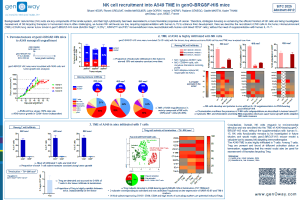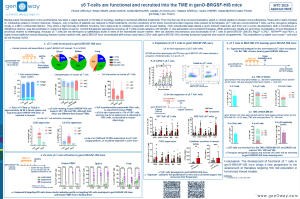Translatable preclinical mouse models for assessment of T-cell engager-induced CRS
BRGSF-HIS & CD3ε in CRS

T-cell engagers are efficient therapeutics in B-cell malignancies. Nonetheless, they display a high risk of serious adverse events in humans, including cytokine release syndrome (CRS). This is why reliable and translational animal models are strongly needed to allow an early evaluation of their safety.
Our participation at Tumor Model Boston
In July, at the Tumor Model Boston 2022 meeting we presented a poster titled: “BRGSF-HIS and CD3ε (CD3 epsilon) humanized mice: Transposable preclinical mouse models for the evaluation of T-cell engager-induced CRS”.
This poster describes two preclinical models enabling the evaluation of potential CRS induction upon injection of anti-CD3-based compounds.
✔️ The first one is the BRGSF-HIS mice, which is based on a highly immunodeficient mouse strain to get a reduced murine myeloid compartment. Its immune system is reconstituted using human CD34+ cells, which allow the development of both human lymphoid and myeloid compartments. The human myeloid compartment can be enhanced after injection of a hFlt3-ligand.
Injection of OKT3, an anti-CD3 antibody, results in the production of various cytokines detected in the blood as well as mouse serum amyloid A. If tocilizumab, an anti-IL6 receptor, is injected before OKT3 injection, then OKT3-induced cytokine release is attenuated. This last result validates the usefulness of the model to evaluate rescue options to control CRS.
Induction of CRS following Blincyto injection was also assessed in this model. A cytokine release in blood is then observed in a dose-dependent manner. These results demonstrate the relevance of the model to assess CRS induced by a bispecific antibody, encompassing an anti-CD3.
➡️ This model has the major advantage of allowing therapeutic assessment in presence of a fully humanized immune system. The main limitation of this model is the partial interplay between human tumor and immune cells and the stroma cells which remain of mouse origin.
✔️ Alternatively, a complete cross-talk between stroma cells and immune cells is recapitulated in the CD3 epsilon syngeneic mouse model, expressing a humanized epitope, which is recognized by anti-CD3 clone SP34. Its design preserves the interaction of the epsilon sub-unit with gamma and delta sub-units of the CD3 complex and its functionality. The model enables the assessment of bispecific T-cell engagers’ efficacy.
In a preliminary study, the capacity of a bispecific antibody targeting a tumor-associated antigen and the human CD3 epsilon was assessed in vitro using splenocytes from the mice and murine tumor cells expressing the TAA. Production of murine cytokines was detected in a dose-dependent manner while it is not with the control bispecific antibody, targeting an irrelevant TAA.
In conclusion, the two models presented here, BRGSF-HIS mice and humanized CD3 epsilon epitope mice, are complementary to conduct early safety studies and assess potential T-cell engager-induced CRS and/or CRS rescue therapies.
Related products
Catalogue product
Customized product

Scientific excellence
From model design to experimental results
Featured in 600+ scientific articles

Collaborative approach
Collaboration with 17 Top Pharmas,
170+ Biotechs and 380+ Academic Institutions

Robust validation data on catalog models
Generated with biopharma partners and in-house

Innovative technologies
and guaranteed freedom to operate

Easy access to models
Models with certified health status from professional breeders in US and Europe




.webp)


























